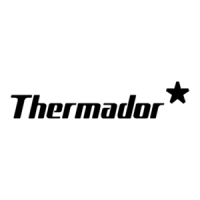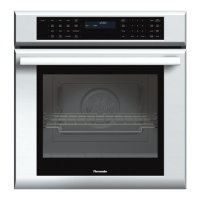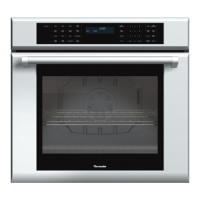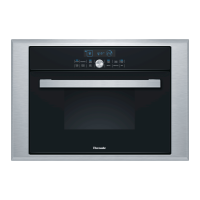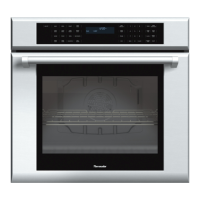Pizza
Tips
Proof
Warm
In the Pizza mode, heat from the lower and upper elements is cir-
culated throughout the oven by the convection fan.
Use the Pizza mode for fresh or frozen pizza.
_ For a crispy crust, place pizza directly on the rack.
_ For a softer crust, use a pizza pan.
_ When proofing dough, coat dough with olive oil and cover bowl tightly with plas-
tic wrap to prevent crust formation.
_ Sprinkle cornmeal on the pizza pan to prevent sticking.
_ If using a pizza paddle, sprinkle the paddle liberally with cornmeal for ease in
transferring the dough to the pan.
_ If par-baking handmade pizza dough, prick the dough with a fork before baking.
_ If using a pizza pan, choose a dark, perforated pan for a more crisp crust and a
non-perforated pan for a softer crust.
_ Preheat baking stones while the oven is preheating.
_ Bake homemade pizzas on rack position 2 in center of the rack.
_ Follow manufacturer's directions for frozen pizza.
_ The convection fan cycles on and off when using pizza mode.
@
In Proof, the oven uses the upper and lower elements to maintain
a low temperature to proof bread or other yeast doughs.
_ Proofing is the rising of yeast dough.
_ The Proof mode temperature range is 85 °F to 110 °F.
_ Loosely cover the bowl or pan and use any rack that accommodates the size of
the container.
_ Keep the door closed and use the oven light to check the rising of the dough.
In Warm, the upper and lower elements maintain a low tempera-
_] ture in the oven cavity in order to keep food at serving tempera-
ture.
_ Use the Warm mode to keep cooked foods hot until ready to serve.
_ Warm mode temperatures are 140 °F - 220 °F.
_ Foods that must be kept moist should be covered with a lid or aluminum foil.
Caution:
When using Warm mode, follow these guidelines:
_ Do not use the Warm mode to heat cold food.
_ Be sure to maintain proper food temperature. The USDA recommends holding
hot food at 140 °F or warmer.
_ DO NOT warm food longer than one hour.
